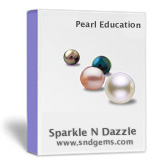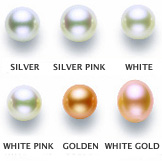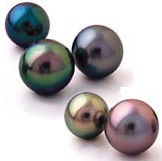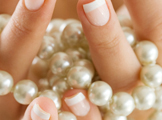

Pearl color
includes: the body color (the primary color - either light, dark, or
colored), the overtone color (a tint that appears super-imposed on
the body color),and a rare component called orient (an iridescent, or
rainbow of colors that generally is found on baroque pearls, or those
with an irregular surface).
The most
valuable pearls in the light body color group are pink, pink rose'
and white rose' with a very high luster, and are well matched, and
round, with a clean surface. The finest dark pearls are black with a
metallic green overtone color. Pearls also come in pastel colors such
as: pink, purple, yellow, golden, green, silver, and blue.
The most valuable overtone color in light pearls is rose', and in black pearls, green is most desirable.

The color of
the "mother-of-pearl" inside the shell determines the pearl
color, depending on the species.

With Akoya cultured pearls, the color and intensity of the color is a distinguishing feature of pearl quality. Low quality pearls often have brown or yellowish body color and do not have overtone or very light overtone. Pearls without overtone look "flat". High quality pearls have deeper overtone color, because the intensity of color is the result of thick nacre and high luster. Pearl processing also effect pearl color.

In naturally "black" cultured tahitian pearls, the color can range from light gray to dark gray to black, and also includes blue and green; overtones are usually green or pink. In black pearls, a green overtone is the rarest and the most costly, especially when it results in an intense "peacock" color.

South Sea cultured pearls come in shades of lustrous white, often with silver or rosé overtones. They are larger in size than the Akoya pearl and are also used in the creation of fine pearl strands and ropes.

Some colors have become more popular than others in particular markets. For example, white pearls are the most popular in America, while silver are more sought after in Asia. This regional color preference usually has something to do with the skin tones of the wearers. Most jewelry experts agree that a buyer's color choice should be primarily based on what will look good on the person who will wear the pearls. In generals, pink pearls look best on fairer skin tones, while yellow or golden pearls look best on darker skin tones.
![]()
Why
Buy From Us | References
| Site Security
| Guarantee | Return
Policy | Buyer's
Tips | FAQ | Site
Map
Product
Education | Live
Online Help | Search
Our Website | Customer
Service | Contact
Us | Payment Options
| Sales Tax
Shipping
Charges | Service
Center | Order
Tracking | Platinum
Facts | Ring Sizing
| Engraving Options
| Polishing
How
To Order | After
Sales Service | Legal
| Terms & Conditions
| Disclaimer | Product
Policies | Security
info@sndgems.com | © 2000 Sndgems Inc. | 1-800-871-1066 / 1-614-921-9024
